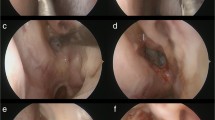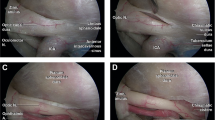Abstract
Purpose
The endoscopic transnasal, transsphenoidal approach is considered by many a valid option to reach the sellar region and, in selected cases, to decompress the optic nerve. However, few data are available in literature about the real effectiveness of the procedure and the extent of nerve decompression needed to obtain a clinical result. The aim of this anatomical study was to describe the most important landmarks of the endoscopic transsphenoidal approach to the optic nerve.
Methods
Six silicone-injected cadaver heads were dissected via the endoscopic transnasal approach, performing a bilateral optic nerve decompression. The lateral optocarotid recess (OCR) and optic canal were identified in each case. Moreover, the relationship between the ophthalmic artery at its origin and the optic nerve was examined.
Results
Twelve decompressions of the optic nerve were performed, obtaining the following measurements: intercarotid distance 12 mm ± 1.5, median length of OCR 5 mm ± 1 and average length of optic nerve decompression 15 mm ± 2. The ophthalmic artery was observed emerging from the internal carotid artery (ICA) medially in six cases, ventrally in four cases and laterally in two cases.
Conclusion
A wide optic nerve decompression may be obtained with transsphenoidal approach. However, the risk of ophthalmic artery injury seems to be more relevant than with supratentorial approaches, due to the intimate relationship between artery and nerve on its inferior surface. Knowledge of anatomical landmarks, such as lateral OCR and the position of the ophthalmic artery, is useful to prevent this injury.



Similar content being viewed by others
References
Avci E, Bademci G, Ozturk A (2005) Microsurgical landmarks for safe removal of anterior clinoid process. Min Invasive Neurosurg 48(5):268–272
Cappabianca P, Cavallo LM, Esposito F, De Divitiis O, Messina A, De Divitiis E (2008) Extended endoscopic endonasal approach to the midline skull base: the evolving role of transsphenoidal surgery. Adv Tech Stand Neurosurg 33:151–199
Catapano D, Sloffer CA, Frank G, Pasquini E, D’Angelo VA, Lanzino G (2006) Comparison between the microscope and endoscope in the direct endonasal extended transsphenoidal approach: anatomical study. J Neurosurg 104(3):419–425
Cavallo LM, De Divitiis O, Aydin S, Messina A, Esposito F, Iaconetta G, Talat K, Cappabianca P, Tschabitscher M (2008) Extended endoscopic endonasal transsphenoidal approach to the suprasellar area: anatomic considerations, part 1. Neurosurgery 62(6 Suppl 3):1202–1212
Chen C, Selva D, Floreani S, Wormald PJ (2006) Endoscopic optic nerve decompression for traumatic optic neuropathy: an alternative. Otolaryngol Head Neck Surg 135(1):155–157
Collignon F, Link M (2005) Paraclinoid and cavernous sinus regions: measurement of critical structures relevant for surgical procedures. Clin Anat 8:3–9
Cushing H (1914) The Weir Mitchel Lecture. Surgical experiences with pituitary disorders. JAMA 63:1515–1525
De Divitiis E, Cappabianca P (2003) Endoscopic endonasal transsphenoidal surgery. Springer, Wien-New York
Frank G, Pasquini E, Mazzatenta D (2001) Extended transsphenoidal approach. J Neurosurg 95(5):917–918
Hardy J (1969) Transsphenoidal microsurgery of the normal and pathological pituitary. Clin Neurosurg 16:185–217
Hart CK, Theodosopoulos PV, Zimmer LA (2009) Anatomy of the optic canal: a computed tomography study of endoscopic nerve decompression. Ann Otol Rhinol Laryngol 118(12):839–844
Jho HD (2001) Endoscopic endonasal approach to the optic nerve: a technical note. Minim Invasive Neurosurg 44(4):190–193
Jho HD (2001) The expanding role of endoscopy in skull base surgery. Indications and instruments. Clin Neurosurg 48:287–305
Koc K, Anik I, Altintas O, Ceylan S (2008) Endoscopic optic nerve decompression for idiopathic intracranial hypertension in two cases: case report. Minim Invasive Neurosurg 51(2):72–75
Lang J, Kageyama I (1990) Clinical anatomy of the blood spaces and blood vessels surrounding the siphon of the internal carotid artery. Acta Anat 139:320–325
Laws ER, Sheehan JP (2006) Pituitary surgery––a modern approach. In: Grossman AB (eds) Frontiers of hormone research, vol 34, Karger, London
Li J, Wang J, Jing X et al (2008) Transsphenoidal optic nerve decompression: an endoscopic anatomic study. J Craniofacial surg 19:1670–1674
Maurer J, Hinni M, Mann W, Pfeiffer N (1999) Optic nerve decompression in trauma and tumor patients. Eur Arch Otorhinolaryngol 256(7):341–345
Patrocínio JA, Patrocínio LG, Júnior FB, da Cunha AR (2005) Endoscopic decompression of the optic nerve in pseudotumor cerebri. Auris Nasus Larynx 32(2):199–203
Rhoton A (2002) The orbit. Neurosurgery 51(4 Suppl):S303–S334
Rhoton A (2002) The sellar region. Neurosurgery 51(4 Suppl):S335–S374
Salcman M, Heros R, Laws ER, Sonntag V (2002) Kempe’s Operative Neurosurgery. Springer Verlag, Berlin
Schmidek Sweet (2000) Operative neurosurgical techniques. Section VI: pituitary tumors. Saunders, New York
Yuen AP, Kwan KY, Chan E, Kung AW, Lam KS (2002) Endoscopic transnasal orbital decompression for thyrotoxic orbitopathy. Hong Kong Med J 8(6):406–410
Zervas NT (1980) Reflections on the surgery of the pituitary. Clin Neurosurg 27:124–132
Acknowledgments
This work was supported by the Ricerca Corrente Funds of Fondazione Policlinico IRCCS, Milan.
Conflict of interest
None.
Author information
Authors and Affiliations
Corresponding author
Rights and permissions
About this article
Cite this article
Locatelli, M., Caroli, M., Pluderi, M. et al. Endoscopic transsphenoidal optic nerve decompression: an anatomical study. Surg Radiol Anat 33, 257–262 (2011). https://doi.org/10.1007/s00276-010-0734-1
Received:
Accepted:
Published:
Issue Date:
DOI: https://doi.org/10.1007/s00276-010-0734-1




